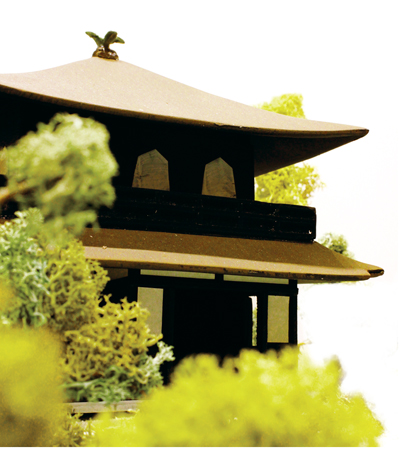
当たり前に日本人として生きてきた。でも海外に出てから、日本について何も知らないことに気が付いた。そこで、日本が世界に誇る世界遺産について建立年順に勉強しようと思う。興味がある人も、そうでない人も、しばしお付き合いを。
I’ve lived my whole life as a Japanese person, but when I went overseas I realised I know practically nothing about Japan. So now I’m learning about Japan’s World Heritage Sites, from oldest to newest. Those who are interested, and even those who are not, come along for the ride.

撮影協力 / メルボルン総領事館 Thanks to the Consulate-General of Japan, Melbourne
○○○○○ 東山慈照寺: 山紫水明の地にひっそり佇む寺院 ○○○○○
今回は、1994年に『古都京都の文化財』のひとつとして世界文化遺産に登録された東山慈照寺(とうざん じしょうじ)を紹介します。通称の“銀閣寺”の方がピンッときますよね。銀閣寺は、“室町時代を代表する建築様式、庭園様式、文化的背景を今に伝えていること”、“日本全国の建築様式、庭園様式の発展に大きな影響を及ぼしたこと”などが評価され、登録されました。
銀閣寺は相国寺の塔頭寺院のひとつで、室町幕府8代将軍の足利 義政(あしかが よしまさ)が、1482年に造り始めた山荘・東山殿が起源。義政の死後に禅寺に改ためられ、法号から慈照寺と名付けられました。江戸時代初期になると、義政の祖父で室町幕府3代将軍の義満(よしみつ)が建てた金閣寺(正式名称、鹿苑寺:ろくおんじ)と対比して、銀閣寺と呼ばれるようになりました。
しかしこの呼び名、金閣寺の舎利殿(しゃりでん:金閣と称する建物)は金箔が貼られて煌びやかなため、銀閣寺と呼ばれるからには銀箔で…と、あらぬ期待を抱かせてしまっているハズ。確か、小学校で「銀閣寺は、財政が苦しくなって銀箔が貼れなかった」と教わった記憶があります。これも誤解のひとつ。観音堂(かんのんどう:銀閣と称する建物)には、元々銀箔を貼る予定はなかったし、最近の調査でも銀箔を貼った形跡が見当たらないという結果が出ています。この誤解には、歴史的背景も影響しているのでしょうね。
そこで、少しだけ歴史を振り返ってみましょう。足利 義政は、1449年に13歳という若さで将軍に就任したため、将軍としての政治の主導権を握ることは困難だったとされています。気の強い母や嫁、更には嫁の実家や有力な守護大名が次々に政治に参入してきて口出しされたら、義政じゃなくてもうんざりしちゃいますよね。そこで、義政が興味を示したのが、芸術の振興、邸宅や日本庭園の造営。飢饉や災害が相次ぐ中、花の御所(はなのごしょ)と呼ばれる邸宅の大改築をしたり、自分の後継者問題から全国規模にまで発展した応仁の乱(1467-77年)で幕府の勢力も財政もガタガタなのに、銀閣寺を作り始めちゃったり。そりゃ、現実逃避だの、お金がなくて銀箔貼れなかったっていわれても仕方がないよーな…。ちなみに義政は、銀閣寺の完成を見ずに亡くなってしまいました。
そんな義政の現実からの逃避行(?)から誕生した銀閣寺ですが、日本文化を語る上でのキーワード“侘び・寂び”の美しさを追求する東山文化の代表的な建造物になっています。金閣寺に代表される華麗な美しさを求める北山文化とは対照的なところが、おもしろいですね。東山慈照寺には、簡素な中にも気品のある観音殿(銀閣)、今なお和式住宅に強い影響を与える書院造の基といわれる東求堂(とうぐどう)があります。そして白砂が壇状にして直線の縞模様を付けた銀沙灘(ぎんしゃだん)と、高さ180cmもある円錐盛りの向月台(こうげつだい)が印象的な枯山水の庭園など、パッと見のインパクトはそれほどでもないのに、グッと心を引き付けてやまない魅力的な場所です。また、現在でも茶会が行われる際に使う『お茶の井』と呼ばれる場所の湧き水は、義政も愛用していたそうです。個人的に、銀閣寺は四季折々の自然にスッと溶け込んだ姿が美しいと思うので、機会があれば、それぞれ違う季節に訪れてみて欲しいと思います。
次回は、古都京都の文化財として世界遺産に登録された 二条城をご紹介します。
○○○Higashiyama Jisho-ji: A temple that melds with the beautiful scenery ○○○
This time we introduce Higashiyama Jisho-ji, another of the ‘Historic Monuments of Ancient Kyoto’ registered to the World Heritage list in 1994. You probably know this temple by its nickname Ginkaku-ji. It was listed for its value as ‘representative of Muromachi period architecture, garden style, and culture’ and as ‘influential on the development of architectural and garden styles in Japan as a whole’.
Ginkaku-ji is a sub-temple of Shokoku-ji. Its was built beginning in 1482 was as a villa called ‘Higashiyama-dono’ for Ashikaga Yoshimasa, eighth shogun of the Muromachi shogunate, but after his death, it was turned into a Zen temple and renamed Jisho-ji. At the beginning of the Edo period, it became known as Ginkaku-ji (‘Temple of the Silver Pavilion’) in contrast to Kinkaku-ji (‘Temple of the Golden Pavilion’, formally called Rokuon-ji)that was built by Yoshimitsu, third shogun of the Muromachi shogunate and grandfather to Yoshimasa.
Because the pavilion of Kinkaku-ji is covered in brilliant gold leaf, it’s likely that you wrongly expect Ginkaku-ji to feature silver leaf... I recall being told in primary school that it wasn’t covered in silver because the money ran out. But this is a misunderstanding; there were no plans originally to put silver leaf on the Kannon hall at Ginkaku-ji, and recent examinations have shown no evidence that silver leaf was ever present.
Let’s look further into the temple’s history. Ashikaga Yoshimasa became shogun in 1449, when he was only 13, so it was difficult for him to take control of the government. There was interference from his strong-willed mother, his wife, his wife’s parents, and the influential ‘shugo daimyo’ (feudal lords). But what Yoshimasa was really interested in was promotion of the arts and the construction of grand residences and traditional landscape gardens. He had massive reconstructions done at his ‘Hana no Gosho’ palace in the midst of crop shortages and natural disasters. He also started the construction of Ginkaku-ji at a time when the shogunate’s power and finances were both shaky from the nationwide Onin War (1467-77) over who would be his successor. It’s no wonder people thought he was out of touch with reality and couldn’t put silver leaf on the temple due to lack of money... Incidentally, Yoshimasa passed away before Ginkaku-ji was completed.
Ginkaku-ji may have begun as an escape from reality for Yoshimasa, but now it is a quintessential architectural example of what became known as ‘Higashiyama Culture’, which pursued the simple beauty of wabi-sabi, a key concept in Japanese aesthetics. It’s interesting that Kinkaku-ji, by contrast, is a key example of the earlier ‘Kitayama Culture’, which aimed for more showy and splendid beauty. In the Higashiyama Jisho-ji temple grounds are the simple yet refined Kannon Hall (known as the Silver Pavilion), and also Togu-do, which is said to be the origin of ‘shoin-zukuri’, an architectural style that strongly influences Japanese housing even today. Then there is the Zen garden Ginshadan, with white sand raked in straight lines and an 180cm-high cone of sand known as ‘Kogetsudai’. These places may not be immediately impressive, but they have a subtle appeal. There is also the spring ‘Ocha-no-i’, reputedly well loved by Yoshimasa; its water is still used for tea ceremonies. Personally, I think it’s beautiful how Ginkaku-ji melds with the scenery in different seasons, so if you have the chance to it’s worth visiting in all four.
Next time we cover another of the History Monuments of Ancient Kyoto, Nijo Castle.

